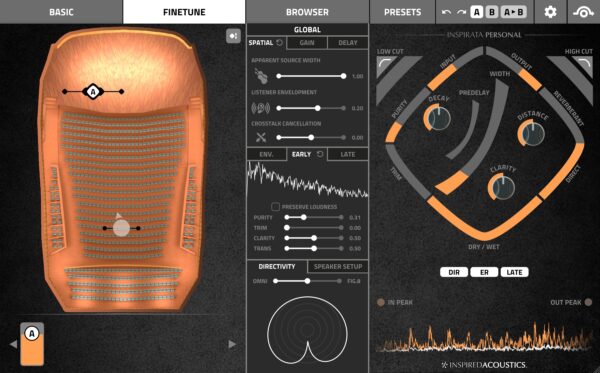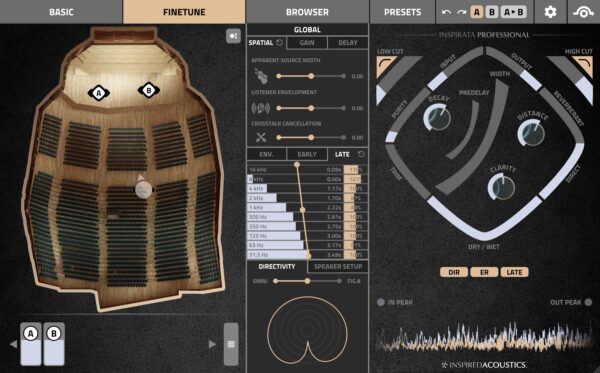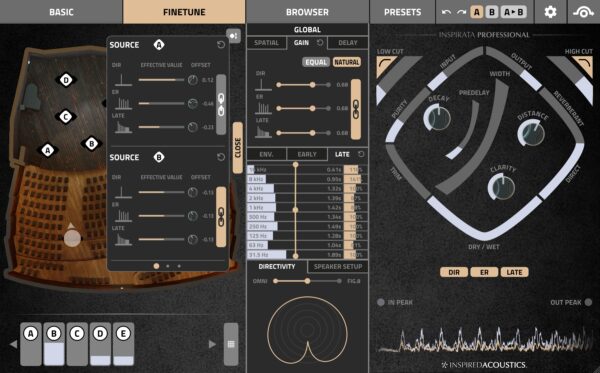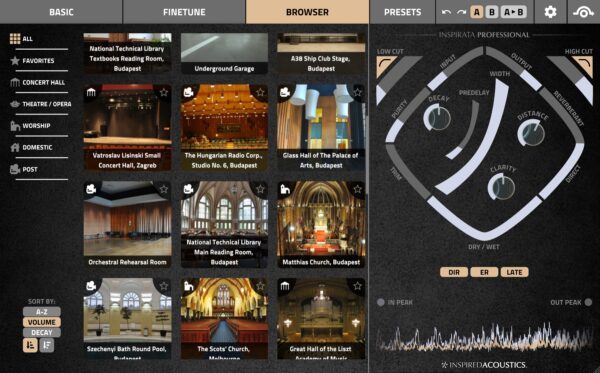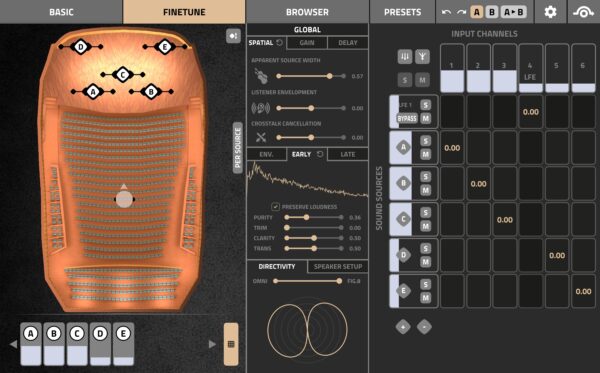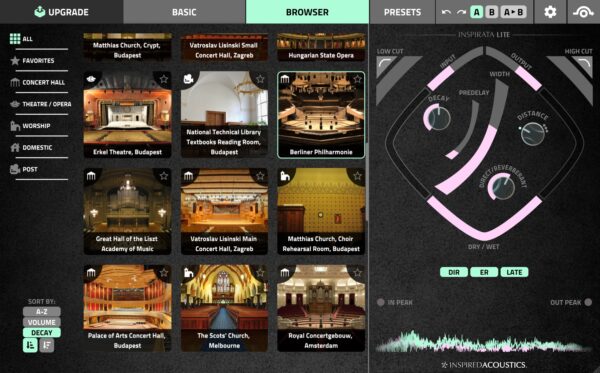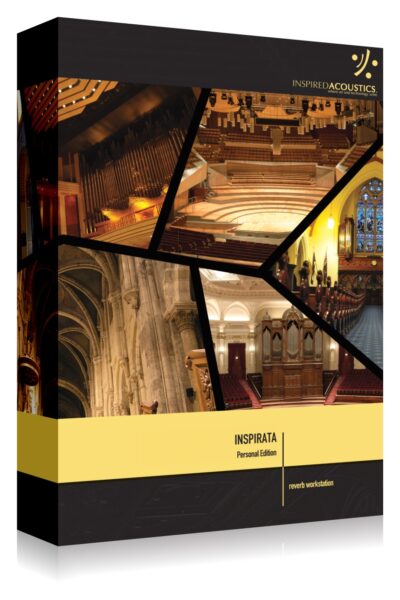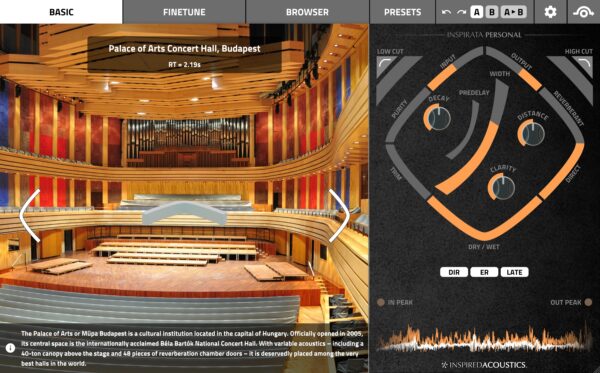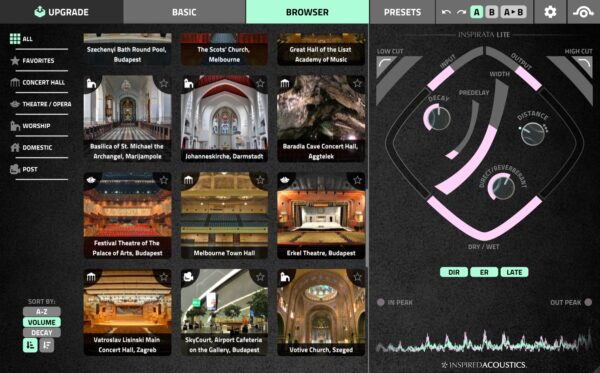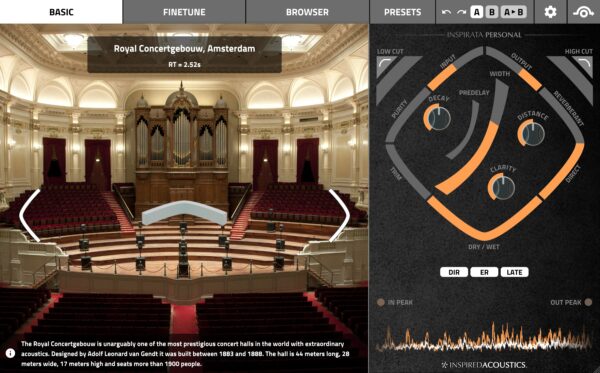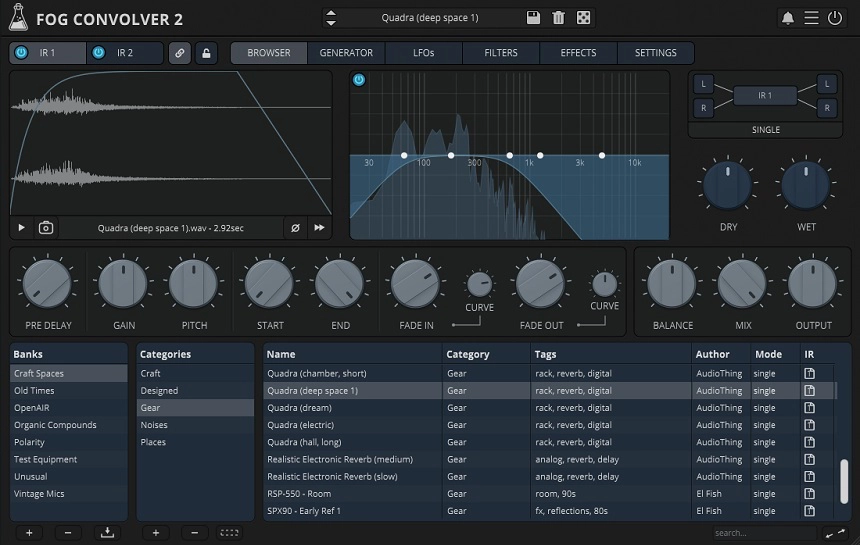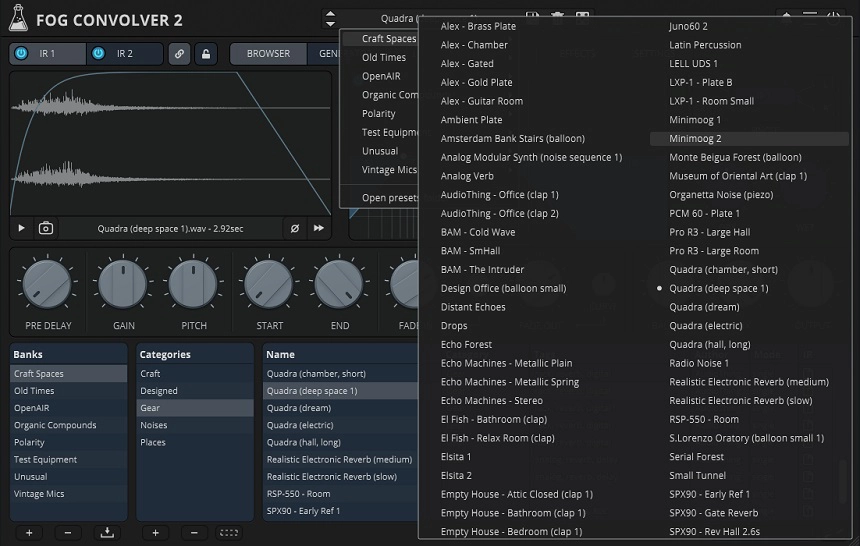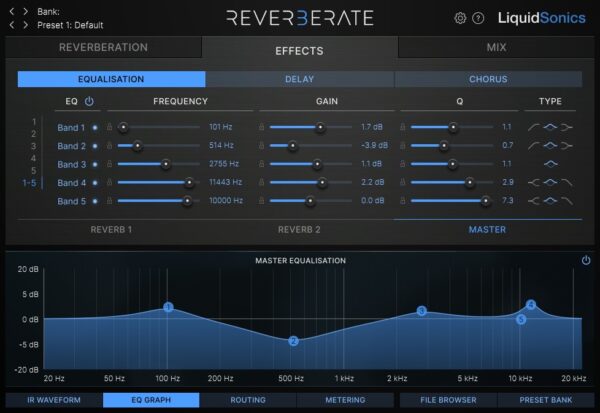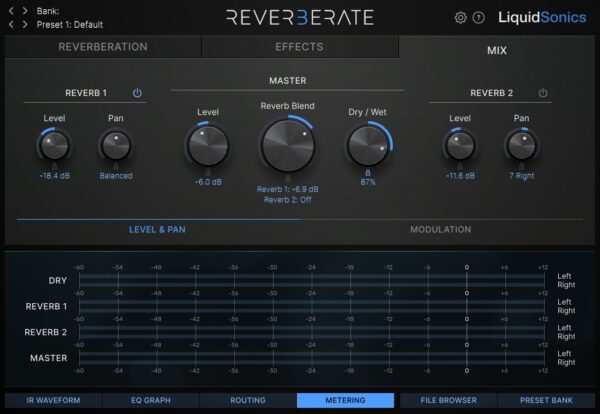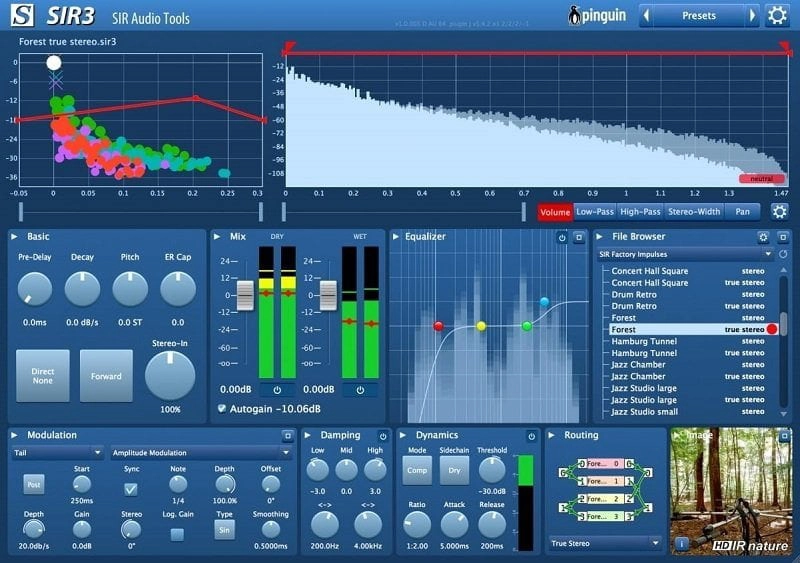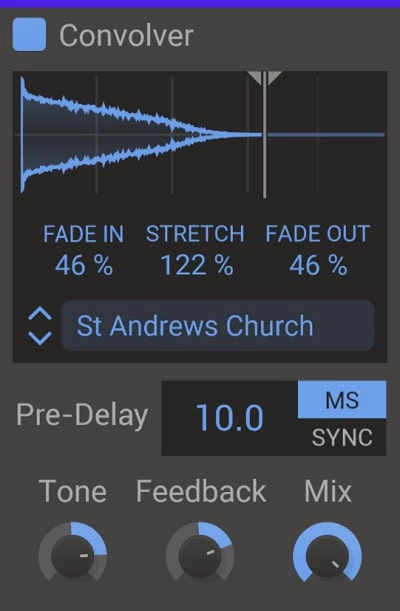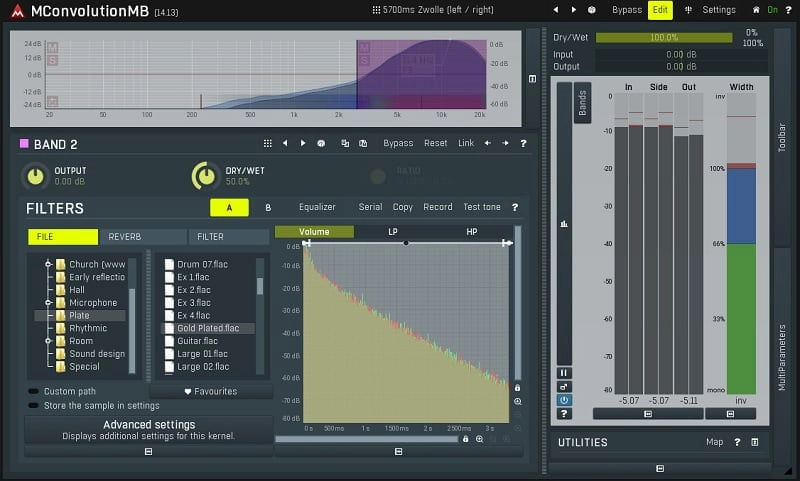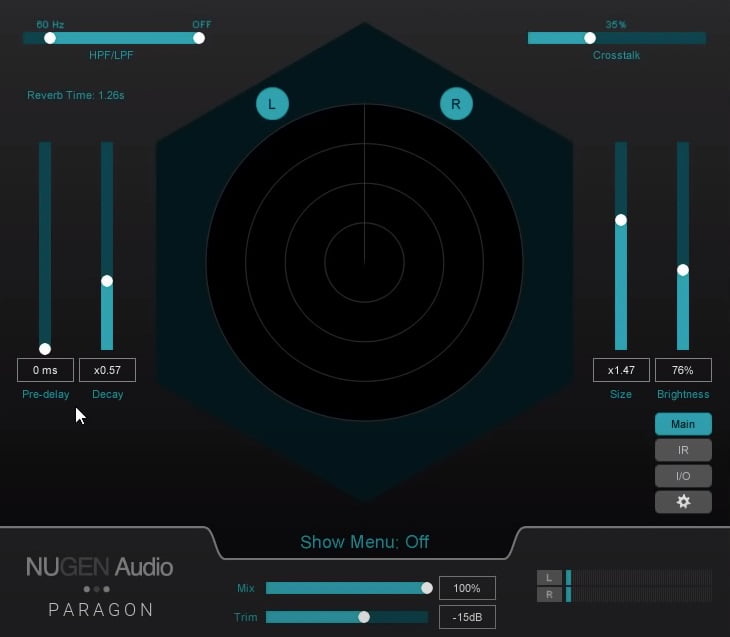In this post, we’ll explore the depths of Convolution Reverbs. We’ll take a look at what they are, how they work, and also how and when to use them. We’ll also talk about what are Impulse Responses and how they work. Additionally, we’ll review the ten best convolution Reverb plugins for 2024!
Have you ever been in a room you wished you could use as an echo chamber? Even though it’s 100 miles away from your studio and you don’t have enough cabling? Convolution Reverbs solve that problem and in the next few lines, we’ll understand how. Continue reading to learn how to use places like The Royal Albert Hall, or your grandma’s kitchen, as reverbs in your songs.
In a nutshell, here are our picks:
1. Inspired Acoustics INSPIRATA
5. Kilohearts Convolver Snapin
9. Waves IR1 Convolution Reverb
10. Halls of Fame 3 – Complete Edition
What is Convolution Reverb?
Convolution Reverb is an effect that digitally simulates how sound would reverberate in a physical space. It uses a recording from the room’s Impulse Responses to generate an echo. Because this type of reverb includes a higher density of reflections than algorithmic reverb, it sounds more realistic.
How Does Convolution Reverb Work?
A convolution reverb blends samples from an environment’s Impulse Responses with the original audio signal. This gives the impression that the audio is naturally being played inside the room. It’s possible to sample any physical space to be used as a preset within a Convolution Reverb plugin.
What Are Impulse Responses, and How Do They Work?
In music and audio, Impulse Responses are the measurable reactions of a room to any noise generated within it. They are recordings of space’s reflections sampled by software. IRs are used to recreating the environment’s acoustic characteristics through a Convolution Reverb application.
How Do You Use Convolution Reverb?
You can use Convolution Reverb on a bus track or even on instrument tracks. You can use it in mono, stereo, or surround configurations, depending on how the IRs were recorded. It is not recommended to have multiple instances of Convolution Reverb on the same session, since it’s very CPU-consuming.
What Is The Use of Convolution Reverb?
Convolution Reverb is an excellent tool for sound designing. Some uses include creating the sense of depth in a musical recording, emulating room acoustics during dialogue replacement, etc. It can also be used in live events by sampling the venue’s IRs and using them to enhance its natural reverb.
When Should I Use Convolution Reverb? (What is it good for?)
Use convolution reverb when you want to give an organic feel to your music. People are not used to hearing sounds without reverberation, since every physical place reflects sound in some way. Convolution Reverb helps people subconsciously feel like a part of the room and the musical recording.
When To Use Rather Convolution Over Algorithmic Reverb?
You should use Algorithmic Reverb when fewer natural results are expected. Since you can modify it to taste, it becomes a more versatile option for creative situations. Convolution, on the other hand, is a cleaner approach, and you’ll use it to make anything sound naturally placed within a room.
Obviously, you can also use Convolution Reverb creatively, especially if you have the IR samples of unusual places. Why not make a synth lead sound like it’s inside a cathedral, for example? Or make a guitar reverberate within a teapot?
The real difference is that Algorithmic Reverb is a digital creation that you can endlessly manipulate, while Convolution will always retain the room’s characteristics.
The 10 Best Convolution Reverb Plugins 2024
1. Inspired Acoustics INSPIRATA
Inspired Acoustics’ INSPIRATA is a cutting-edge immersive reverb plugin that provides realism and control over your audio space.
Using a proprietary time-variant convolution technology, it is a unique and immersive computational reverb that provides samples of 50 real acoustic spaces in great detail, from cathedrals to bedrooms. It allows you to move, position, and automate multiple sound sources and the virtual microphone in a real acoustic space, adjusting various acoustic parameters.
Inspired Acoustics offers the reverb plugin in four different editions: Lite, Personal, Professional, and Immersive. The Lite edition is an easy-to-use version of the reverb workstation, while the Professional edition provides an extended feature set and flexibility never before seen in sampled reverbs.
The Immersive edition is the flagship version of INSPIRATA, with support for surround configurations up to 22.2 and a lifetime plan for future room content created by Inspired Acoustics. Each edition has a growing library of real-space content and revolutionary controls, allowing you to move around sound sources and listener position and adjust acoustic parameters.
Key Features:
- High-Quality Impulse Responses
The plugin uses meticulously captured half a million impulse responses from real-world spaces, all included in 50 spaces, providing incredibly realistic and natural-sounding reverberation.
- Extensive Preset Library
You get a large preset collection for Guitars, Vocals, Strings, and Percussions, representing various acoustic environments, such as concert halls, churches, recording studios, etc. These presets make it easy to find the perfect space for your project and can serve as a starting point for further customization.
- Immersive 3D Audio
The plugin supports various audio formats, including stereo, surround, and Ambisonics, enabling fully immersive audio experiences for various applications.
- Surround sound
INSPIRATA offers a vast selection of surround mix options, including the latest Dolby Atmos® technology. Its Immersive Edition supports surround configurations up to 22.2, allowing you to place sound sources at any head height point in the virtual space.
- Intuitive User Interface
The plugin features a visually rich and user-friendly interface, making navigating and manipulating virtual spaces and audio sources easy. It consists of the tabs: Basic, Finetune, Browser, and Presets, among which you can navigate the plugin and control it.
For example, the browser window lets you browse various spaces like Bedrooms, Basements, Small offices, etc. The interface also shows a visual/image of the space it emulates, making the overall user experience more interactive.
- Advanced Controls
You have access to a wide range of controls, including room distance, clarity, decay, pre-delay, width, etc., and even individual reflections, providing a high level of customization for the sound and space.
Further, in the Finetune window, it lets you customize your room in great detail by choosing the position of the sources and the listener and controlling Global parameters like source width, listener envelope, crosstalk cancellation, etc., which are unique to the plugin and cannot be found in any other plugin.
Compatibility:
INSPIRATA’s compatibility is extensive, as it is available in VST, VST3, AAX, and AU formats. This ensures the plugin can be used with various digital audio workstations (DAWs) and platforms, including popular options like Ableton Live, Pro Tools, Logic Pro, and FL Studio.
Next, it is available in four different editions, Lite, Personal, Professional, and Immersive, for Mac and PC. Its library requires over 100GB of space, offering a vast selection of surround mix options.
Summary:
INSPIRATA by Inspired Acoustics is a cutting-edge convolution reverb plugin that delivers stunning realism through high-quality impulse responses. It supports stereo, surround, and Ambisonics formats, enabling immersive audio experiences for diverse applications. You can easily shape virtual acoustic spaces with an intuitive interface and advanced controls.
The extensive preset library offers endless possibilities for music producers, audio engineers, and sound designers seeking the ultimate reverb solution.
2. AudioThing Fog Convolver 2
More Info & Price (Trial Available)
A genuinely stereo spatial tool that responds to every nuance dynamically.
Convolution reverbs are new and recent in the history of this effect. The nicest part about this type of effect is that impulse responses are used in the spatial context of your effect, which allows you to recreate more accurately how a reverberation would occur in a given environment.
Key Features:
- IR selection
The top left corner’s “IR 1” and “IR 2” buttons allow you to choose which impulse response is presently being changed, with the option of swiftly skipping any of the two. The little “Link” button (the small chain) connects the settings for both inputs, and the “Lock” button disables all parameters except the IR, which is loaded from a preset.
- Graphic EQ
The inbuilt equalization may be turned on and off at any moment. There are five bands, and the ability to control each one with a mouse click while the mouse wheel adjusts the “Q” factor of that band. Each band may be reset to its default setting by double-clicking it.
- Routing section
The little piece in the far right corner of the screen is in charge of determining the effect’s proper routing. You can select one of five routing modes: “Single,” “Serial,” “Parallel,” “Parallel Mix,” or “True Stereo.” You may also change the “Balance,” “Mix,” and “Output” settings for each IR.
- General parameters
The nine general parameters are controlled by the grey knobs. “Pre Delay,” “Gain,” “Pitch,” “Start,” “End” (sets the start or end point for the IR), “Fade In,” “Fade Out,” “Curve,” “Balance,” “Mix,” and “Output” are among them.
- Parameter lock
If you need to prevent some parameters from changing values, utilize the “Parameter Lock” option to make them unchangeable. If a parameter is locked, it will not be changed by any modifications, which may be specified for all parameters or just one.
Compatibility:
This plugin is available for macOS 10.9 to 12 (64-bit only) and Windows 7 or higher (64-bit only). It runs in VST2, VST3, AAX, CLAP, and AU plugin formats.
Summary:
The wonderful thing about current plugins is that they frequently surpass our expectations. Thinking of anything as a reverb with personalized impulse responses is quite the future, and it’s about time we started using some cutting-edge technologies in our job endeavors.
Fog Convolver 2 masterfully mixes contemporary IR modeling with classic controls and settings, providing an unmatched sound texture to whatever ambient you wish to create in your track..
Related Reading:
Top 12 Reverb Plugins (And 5 Best FREE Plugins)
3. LiquidSonics Reverberate 3
More Info & Price (Trial Available)
Reverberate 3 by LiquidSonics is a dual-engine Convolution Reverb plugin that enables thorough IR modulation.
The plugin’s layout is divided into 7 regions, with preset and bank selection, settings, and assistance menu at the top. At the center of the UI is the visualization zone. You can use the Panel Selector at the bottom to browse between visualization zones or collapse them altogether. At the Panel Selector, you can also open the File Browser to easily import your own IRs. The top panel contains the controls for Reverberation, Effects, and Mix.
Key Features:
- Reverb Topology
Start by loading an IR and choosing the reverb’s topology. This plugin’s engine ensures all topologies have stereo outputs, even from mono files. You can also upload quadrophonic (or true stereo), as well as Fusion-IR files. To load in an IR file you can drag and drop it into the plugin or use the file browser.
- Reverberation Menu
Once an IR file is loaded up, you’ll have access to more controls that vary according to the uploaded file. If you load files that contain early and late information, for example, you’ll be able to modify the relation between the two pieces of information to your liking.
Even so, the Shape, Envelope, and Split Mod editing tabs are everpresent, and they allow you to modulate the impulse response with controls such as pre-delay, crop, attack, decay, depth, and more. You can also add a second reverb and repeat the process in the Reverb 2 tab, selectable below.
- Mix Menu
This page allows you to blend both reverbs with the signal for extra convolution. You can also pan each reverb to a different side and achieve interesting results with wide stereo separation, or access the Routing panel to change how the signal goes through the chain.
- Effects Menu
In this menu, you’ll get effects for both reverbs, and for the mixed-signal, individually. The Equalizer gives you a five-band, twice over-sampled paragraphic EQ that lets you control each band separately, as well as make fine adjustments to the whole spectrum.
The Delay effect gives you two independently controlled delays for the Left and Right channels and three blend controls. You can sync both delays to the session or manually adjust them. The idea behind them is to allow you to recreate inconstant tape delays as naturally as possible.
Finally, there is a Chorus effect that lets you control the modulation, width, character, delay, rate, and feedback.
- Advanced Features
Reverberate 3 allows you to extend your IR possibilities by synthesizing early and late reflections. These have to be enabled in the plugin’s settings as additional topologies. The Early Reflections Synthesis works in two main modes: Diffused Delays, which sounds more colored and classic, and Enhanced Bursts, designed to be more robust and modern-sounding.
The Late Reverb Synthesis simulates a very dense reverb tail, which you can shape and diffuse to taste using the modulation controls. For further sound expansion, try placing an Early Reflections Synthesis on Reverb 1 and a Late Reverb Synthesis on Reverb 2.
Character and Sound:
Even if your own IRs aren’t numerous, Reverberate 3 comes with several factory banks to let you start instantly. You can go from mild to unbelievable reverb with this plugin’s range and control set. In other words, you control the sound.
Compatibility:
This plugin is available for 64-bit only macOS 10.9 and higher and Windows 7 and above in VST, AU, and AAX formats.
Summary:
Versatility is the name of the game with this convolution reverb plugin. The algorithmic-style controls turn the plugin’s presets or your own IRs into whatever you want. With so much attention to detail, it’s easy to spend a long time shaping your sound.
Reverberate 3 is a plugin for reverb aficionados who want to immerse the listeners in the recording. An awesome plugin to have in your collection.
Related Reading:
Top 6 Reverb Plugins For Your Vocals
4. SIR3 Convolution Reverb
More Info & Price (Trial Available)
The SIR3 is a zero-latency convolution reverb with Dynamic controls and 33 High Definition Impulse Responses.
This plugin handles true stereo IRs in a four-step modulation chain. The parameters range from the usual suspects to the unexpected, which lets you achieve organic and unreal-sounding results.
You can adjust the reverb’s head and tail separately, as well as applying gating, damping, and equalization.
Key Features:
- Modulation Type 1
The first is Amplitude Modulation, which creates a tremolo effect by syncing to the session. You can choose between four waveforms to create different effects, as well as different note values for slower or faster oscillations.
- Modulation Type 2
The second modulation type is Random Modulation & Delay, which is a multi-stage delay with random amplitude and pitch modulations in the feedback path. This means the signal travels back and forth in the stereo field randomly changing in tone and volume.
- Dynamics
The dynamics controls in this plugin only affect the wet signal, so you can use a Sidechain to trigger the reverb in two ways. You can use the Dry signal to control the loudness of the wet by choosing Sidechain Dry.
In compressor mode, this means the reverb will lower in volume as the input signal is being played and increase when it’s quiet. In Gate mode, it will create a gated reverb effect. By choosing Sidechain Wet, the signal will be controlled by itself, like a regular compressor, adjusting the dynamics of the reverb sound.
- ER Cap
This knob located within the Basic menu controls the volume of the early reflections, managing the room’s apparent vividness. Negative values will mute the early reflections above the threshold, and positive values will mute the ERs below it.
As you mute the reflections, you’ll get instant visual feedback in the Early Reflections and Impulse graphics. You can adjust the threshold by clicking and dragging the red line.
Character and Sound:
The plugin’s notable array of parameters is enough to get interesting sounds out of this otherwise transparent reverb plugin. The 33 built-in high-definition impulse responses recorded and developed by Pinguin Ingenieurbüro, from Germany, give sufficient possibilities, which the plugin improves greatly.
Compatibility:
The SIR3 is available for macOS 10.9 or newer and Windows 7 or newer as a VST, AU, and AAX plugin.
Summary:
By delivering the basics and a little more, this convolution reverb plugin is an excellent choice if you’re not planning on going too wild with your productions. The factory IRs sound amazing and the interface is very straightforward. The SIR3 offers low CPU consumption and high-quality sound, but not without a salty price.
Related Reading:
The 6 Best Spring Reverb VST Plugins | AudioThing, GSi, u-he, Eventide
5. Kilohearts Convolver Snapin
More Info & Price (Trial Available)
Snapins are effect plugins belonging to Kilohearts’ growing ecosystem of instruments and effect processors.
You can use Snapins in many host plugins by Kilohearts, such as Multipass band-splitter and Phaseplant, a powerful modular synthesizer. This concept makes Kilohearts’ plugins some of the most powerful ones available today. That said, you can also use Snapins separately in your DAW.
If you use Kilohearts’ host plugins, you’ll also find all your presets built in them in your standalone Snapins.
Convolver is a convolution effect processor that uses impulse response (IR) to generate various types of effects, including reverb. An impulse response is a recording of a loud click in a specific location or passed through one or a series of hardware gear.
So, you could create an impulse response of your guitar amp, vintage effect units, and filters alongside strange locations like a pipe. Import them into Convolver, and it emulates the effect instantly.
Key Features:
- IR Editor
Convolver provides various features that allow you to edit the impulse response audio sample non-destructively. You can change the start and end position of the audio sample. And you can add a fade-in or fade-out.
Furthermore, the stretch parameter lets you adjust the length of the audio sample, a handy feature when you want to reduce the reverb length. Similarly, the reverse button changes the playback direction of the sample, producing creative sounds.
- Sample Library
Convolver features a built-in sample library with over three hundred impulse response files. These include a variety of locations like churches, cathedrals, halls, rooms, outdoor places, etc., and digital reverbs.
You’ll also find other types of IRs like amp cabinets, effect units, etc. However, the main concept of this Snapin is to use custom IR samples from the internet or even random audio files. You never know what such wild experiments could bring!
- Other Features
The plugin lets you change the pre-delay in milliseconds or fractions of beats. Similarly, the tone knob controls the brightness of the wet sound, and the feedback parameter feeds the processed output back into the convolution engine.
It can create echoes, longer reverbs, or a “reverb freeze” effect. And finally, the mix knob lets you control the dry and wet signals.
Compatibility:
Convolver is available for Windows 10 or higher and macOS 10.6 or higher, both 64-bit only. It comes in VST 2/3, AU, and AAX formats.
Summary:
Convolution is one of the preferred ways to generate a realistic reverb effect. It can capture the exact sound of a specific hall from a particular position of listening and reproduce the experience using mathematical processing.
Most other convolution effects provide a large collection of built-in impulse responses. And while Convolver does come with over three hundred IR samples, it maintains modesty to lower its price. So, if you want a high-quality, straightforward convolution effect that can load custom samples, Convolver is an ideal choice.
6. Altiverb 7 Regular
More Info & Price (Trial Available)
The Altiverb 7, by Audio Ease, contains hundreds of built-in IRs recorded at various places in the world.
The plugin’s impulse response collection contains studios, concert halls, cars, churches, schools, analog gear, and many more. You can use the menu to search by keyword, size, or kind of room. On top of that, it lets you shape the EQ in a four-band graphic, add artificial brightness and reverse the reverb signal.
Key Features:
- Positioner
Since the team at Audio Ease were the ones who recorded all the IRs, they made sure to record the rooms from several angles. This allows you to use the Positioner feature to select where in the room you want your sound to come from.
Just drag the speaker icon around on the interface’s virtual floor and find the sweet spot for your instruments. You can add additional instances of the plugin on instrument tracks and simulate they’re coming from different points in the room.
- Pictures
if you hover the mouse over the picture on the left half of the plugin’s GUI, a few controls will appear. VR brings up a surround picture of the room, and you can click the Zoom button to make it interactive.
Previous/Next moves through all images of the current IR. Config shows the speaker-microphone configuration being used. Zoom pops out the image and displays it in a separate, resizable window.
Character and Sound:
The difference from Altiverb to most other Convolution Reverb plugins is its extensive IRs library that encompasses music production and audio post for video. Sonically, it’s as transparent as it gets, with very few modulation options. The plugin’s idea is not to allow extreme experimentation, but to reproduce the places it’s sampled as best as possible.
Compatibility:
Altiverb 7 Regular is available for Mac and Windows as a VST, MAS, RTAS, AU, and AAX plugin.
Summary:
An excellent plugin for both music and audio post-production. The ongoing IRs updates make it a convolution reverb industry standard. Consequently, it is priced accordingly, out of the reach of many bedroom producers. But if you can get it, don’t waste your time and add Altiverb 7 to your collection.
7. Eastwest Sounds Spaces 2
More Info & Price (Trial Available)
The high level of detail in Spaces 2 is astonishing; by selecting an exclusive instrument reflection, you can set the reverb to behave ideally according to the featured instrument. The plugin includes hundreds of environments, opera houses, catacombs, train stations; any producer will have a stunning palette of the reflective fields to choose from with Spaces 2.
Key Features:
- Instrument Specific
By respecting the instrument’s shapes, functionalities, architecture, resonance, and energy, Eastwest Sounds made highly optimal reverbs according to many possible placements of an orchestra.
For instance, when producing a French Horn’s reverberant energy, the team behind Spaces 2 created an impulse for the sound going to the center and lateral rear of a stage since this instrument launches its sounds backward.
- Main Control
With four highly intuitive knobs, you can shape and adjust some crucial characteristics of the reverb. With the input, Pre-Delay, Dry and Wet knobs, the presence of the track’s reflections can be accurately regulated. You can also use the navigation bar to save, load, and browse presets.
- Sections
Spaces 2 has some exciting sections that provide you with more in-depth customization controls. In a Page section, a Center Display will be present; you can activate a Decay and a Filter there. While using the “Display” key, you will switch between the normal display state.
A Mode section offers you control over a Mono or Stereo setting. You can also toggle a True Stereo key to load a stereo-in and stereo-out preset.
- Presets
Featuring an enormous amount of presets, Spaces 2 offers every producer a vast amount of possibilities for implementing reflective textures on their tracks. There are more than thirteen environments for spaces that you can choose from, like caves, courtyards, forests, parking garages, rock rooms, and more.
The presets can fall into different and exciting categories, such as Mono-in/Stereo-out, Stereo-in/Stereo-out, FR (Recorded at the front of the stage), RR (Recorded at the rear of the stage), and more.
Compatibility:
This plugin is available for Windows 10 or higher and macOS 10.13 or higher, both 64-bit only. It comes in VST 2/3, AU, and AAX formats.
Summary:
Spaces 2 is a modern convolution reverb by Eastwest Sounds. The plugin is highly versatile in providing specific reverb for any track by featuring an instrument-specific preset dedicated to some orchestral instruments.
The many preset that the plugin offers are astounding; you can select from an extensive list of environments and ambients to emulate authentic early reflections and tail recordings for any audio. Some intuitive and handy knobs can be adjusted in the primary control with swiftness and precision to maximize further or regulate the mix’s reverberant glow.
8. Melda MConvolutionMB
More Info & Price (Trial Available)
The MConvolutionMB is Melda Productions’ 6-band convolution reverb plugin.
Each band supports two IRs, whether generated by the plugin or imported as files. You can adjust the balance between the two different IRs with the band’s Ratio knob. The plugin also comes with Melda signature features, such as global and per-band randomization, Edit Mode, and several hidden settings menus in which you can fully customize your sound.
Key Features:
- File, Reverb, & Filter
These three browser menus allow you to add different effects to any of the six bands. You can choose two of the same or from different categories. Files are your own IRs located on your computer.
Reverb contains IRs built-in with Melda’s software. Lastly, Filter contains a list of processing settings you can add to accelerate your workflow. Since each band allows up to two effects, you can add a total of twelve effects to this plugin.
- Harmonics
By right-clicking any band, you’ll open the Band Settings menu, where you’ll find general controls, such as frequency, Q, gain, and panorama. Below these, there is a panel called Harmonics. It has three parameters, Maximal Count, Semitones, and Harmonics.
Underneath them, there’s a Grid. These controls allow you to create clones of the main band at higher frequencies. They are excellent for removing natural noises, which can bring harmonics with them.
- Kernel Settings
This is the heart and soul of the plugin’s modulation capabilities. Each band supports two Kernels, which can be the aforementioned File, Reverb, and/or Filter. Each Kernel has 15 adjustable parameters, plus a six-band equalizer. Among the available parameters, you’ll find Pitch Shift, Left and Right Delay, Modulation Depth and Rate, Gain, Widening, and many more.
Character and Sound:
At the end of the signal chain, there is a master equalizer that affects the reverb sound before it blends back with the dry signal. In it, there is a saturation knob that simulates the soft saturation an analog equalizer would add to the sound.
It’s a subtle touch, but it adds character to the reverb, which is something most plugins on this list don’t do. Alternatively, you can add saturation through the EQ available within each Kernel.
Compatibility:
This plugin is available as a VST, AU, and AAX plugin for 64-bit only Macs running macOS10.9 and newer, and 32- and 64-bit PCs running Windows 7 or up.
Summary:
Believe it or not, Melda’s done it again. The MConvolutionMB lives up to the brand’s reputation of providing producers with affordable, fully customizable tools so they can make their own sound. If you’re one of those that absolutely must tweak everything until it sounds perfect, this plugin is for you.
Related Reading:
Top 12 MeldaProduction Plugins For Music Production
9. Waves IR1 Convolution Reverb
More Info & Price (Trial Available)
Waves’ IR1 is designed to be the perfect hybrid between synthetic digital reverbs and acoustic convolution reverbs.
Containing an extensive library of IRs from famous places around the world, the IR1 also supports your own files. It provides the standard controls expected from a convolution reverb, plus a couple of nice additions. Moreover, the damping section lets you make precise adjustments.
Key Features:
- RT60
In architecture and building construction, the term RT60 is used to describe a room’s acoustic properties. Use this type-in area to select how long it will take for the reverb’s level to drop by 60dB, thus defining its slope.
- ER Buildup
This button allows control of the early reflections’ buildup slope. The smaller the value, the more transient information the ERs will carry. Therefore, a larger value means smoother early reflections’ attacks. The Buildup ranges from 0 to 150 milliseconds.
- ER/TR-X
Located beneath the ER Buildup, this button lets you modify the time reference point that splits the Early Reflections from the Tail Reflections. It ranges from 0ms to roughly 100ms. As you load a new IR, this value is automatically calculated, but the button is here to allow you to change the proportion and bend the sound to your liking.
- Presets
The IR1’s built-in library covers most uses professional studios would require. But the real magic is with the three other IR packages that need to be downloaded from the Waves website.
These other packages include famous places from Italy, Japan, Israel, Australia, the UK, the USA, and many more, as well as classic reverb hardware units, and synthetically generated or pre-processed IRs.
Character and Sound:
The IR1 is a clean-sounding plugin that delivers smooth convolution. It doesn’t add any character or distortion, focusing on simple controls and sound. You’ll use it mainly for generating believable room representations.
Compatibility:
The IR1 is available as a VST, AAX, and AU plugin for 64-bit only Windows 10 and macOS 10.13 through 11.2.
Summary:
This plugin works efficiently with true stereo files and the IR collection is satisfying in number and sound quality. The IR1 is a V12 plugin, which means it’s been updated for more recent systems. If you’re in the Waves ecosystem, this plugin is an excellent addition to your collection.
Related Reading:
20 Best Waves Plugins For Mixing, Mastering & Producing
10. Halls of Fame 3 – Complete Edition
Best Service’s Halls of Fame 3 is a clean-looking plugin that emulates 13 reverb classics.
The IRs were captured from famous spring, plate, and even algorithmic reverbs from the last 50 years. The plugin also boasts an impressive collection of over 1500 unique stereo and true stereo IRs. The interface keeps it simple but allows some interesting sound tweaks.
Key Features:
- Iconic Sounds
The Halls of Fame plugin contains 13 iconic hardware reverbs, with several presets for each. The goal is to give you as much control as to feel like you own the originals. Some of the modeled vintage pieces are the AKG BX 20 (1965), EMT 250 (1976), Lex 480 (1987), and Lex 300 (1998).
- Normalize
As you tweak the other parameters, you’ll notice the reverb will start getting quieter. This can happen because the IR’s loudest peak might have been cut or faded into. To counter this, click the Normalize button to maintain a consistent volume level. If you notice distortion, adjust the Input/Output knobs until there’s no more distortion.
- Free Version
This plugin offers a free version with only two presets for each IR. The idea is to give you a taste of the iconic IRs the Complete Version offers. It’s worth a shot if you feel like this could be a great plugin for you and want to give it a try.
Character and Sound:
This is not a plugin for extreme creative uses. The parameters will help you tune the sound to your taste in a transparent way. Unless you crank up the input and normalize the output. Otherwise, its warm sound comes from the flabbergasting collection of presets available with the plugin’s purchase.
Compatibility:
The Halls of Fame 3 is available in AAX, AU, and VST formats for macOS 10.12 and up and Windows 7 and higher.
Summary:
Best Service’s Halls of Fame 3 is an excellent plugin with a user-friendly interface. The parameters are a little limited if you want to go wild with your IRs, but the number of presets is a hard point to ignore. In conclusion, it’s an excellent addition to your collection, especially if you’re into old-school reverbs.
Best Free Convolution Reverb Plugins 2024
1. Convology XT
The Convology XT is a free-to-download plugin that comes with 70 built-in Vintage Reverb Impulse Response files.
You can also buy the additional parts of the library, which total 2965 files. Among those are sampled amplifiers, all kinds of springs and DSPs, tape delays, and many more. Additionally, you can import your own 4-channel WAV/AIF true stereo files.
Key Features:
- Fast File Browsing
Convology’s greatest feature is the Library, in which you can quickly navigate. The plugin lets you select Impulse Responses on the fly while listening to the input material being processed in real-time. This feature is excellent for quick comparisons between files, which helps you choose the best preset instead of waste a long time tweaking every parameter.
- Freebie Fridays
If you subscribe to Impulse Record YouTube Channel, you’ll receive free vintage gear impulse responses every week!
Character and Sound:
Other than its library, the Convology XT doesn’t offer any uncommon parameters. It relies on the sampled gear’s original tones and character to build its sound. And because the samples are faithful recordings of vintage gear, the plugin offers no emulated analog features that would distort the original’s sound.
Compatibility:
Convology XT is available in AAX, AU, and VST formats for Mac and Windows.
Summary:
This is an excellent free plugin with high-quality samples, even if it doesn’t allow very flexible results. It solves the problem some plugins pose regarding file browsing, and the analog sample collection is astounding. It’s a worthy addition to your collection if you’re into classic gear.
2. MeldaProduction ConvolutionEZ
Melda Production’s ConvolutionEZ is a free plugin by the same developers of MConvolutionMB.
And before we start, this is not a free version of that plugin. It’s an entirely different proposal that achieves very distant results. The ConvolutionEZ is a single-band convolution reverb with a surprisingly big impulse response library.
Key Features:
- Samples
From basic rooms to sound-design-oriented environments, the ConvolutionEZ is an extremely versatile plugin. It covers from the most commonly found plates, different-sized rooms, and halls to box and household items simulations. All this enables you to work on virtually any project with satisfying results.
Character and Sound:
The plugin offers very few controls, which means that you’ll have to trust the sound of the samples. You can apply low- and high-pass filters and blend the input and output signals. Other than that, you can enhance the stereo widening and, when using a stereo input, you can check the balance between the mid and side channels using the Width meter.
Compatibility:
The ConvolutionEZ is available as a VST, AU, and AAX plugin for 32- and 64-bit PCs running Windows 7 or up, and 64-bit only Macs running macOS10.9 and newer
Summary:
The second Melda Productions plugin on this list is a freeware that can hardly live up in versatility to its paid cousin. Even so, it’s a great way to enter the Melda ecosystem and use your own IRs or the plugin’s vast library. The ConvolutionEZ is a nice addition to your collection if you need interesting and unique IRs to work with.
3. Halls of Fame 3 Free Edition
The Free Version of Halls of Fame offers the same 13 unique pieces of modeled hardware, although with only two presets each.
You also get access to all the same controls and functionalities from the Complete version. The plugin lets you automate every parameter through your DAW, but unfortunately, you can’t import your own IRs.
Key Features:
- Iconic Sounds
The Halls of Fame Free plugin contains 13 iconic hardware reverbs, with two presets for each. Some of the modeled vintage pieces are the AKG BX 20 (1965), EMT 250 (1976), Lex 480 (1987), and Lex 300 (1998).
- Normalize
As you tweak the other parameters, you’ll notice the reverb will start getting quieter. This can happen because the IR’s loudest peak might have been cut or faded into. To counter this, click the Normalize button to maintain a consistent volume level. If you notice distortion, adjust the Input/Output knobs until there’s no more distortion.
Character and Sound:
You can tune the samples in a transparent way with this set of controls. Furthermore, by reversing the sound you can get interesting results and squeeze a little more out of the 26 presets present in this free version.
Compatibility:
The Halls of Fame 3 – Free Version is available in AAX, AU, and VST formats for macOS 10.12 and up and Windows 7 and higher.
Summary:
This version feels like a free trial you can keep, although the free trial would probably showcase more presets. It feels incomplete, but the presets chosen sound beautiful nonetheless. Download it if you believe you need a test run before buying the complete version.
Bonus:
NUGEN Audio Paragon
More Info & Price (Trial Available)
Paragon by NUGEN Audio is a Dolby Atmos-compatible convolution reverb that creates unique locations via re-synthesis.
The plugin analyzes the impulse response file, breaks it down, and resynthesizes it to create new authentic locations. Apart from that, it offers a wide array of controls. The Main panel gives you control over the reverb’s overall sound, with Pre-delay, Decay, Size, and Brightness controls.
The IR panel gives you more controls, but this time focused on shaping the impulse response’s sound. Here you’ll find different test sounds, a graphic EQ, and an interesting Complexity slider.
Finally, the third panel is the I/O, which provides monitoring, decay, pre-delay, and crosstalk features for each channel independently. Additionally, you can access the Settings panel to reach routing controls for surround information.
Key Features:
- Complexity
Accessible through the IR panel, this feature adjusts the reverb’s richness. Higher values increase the number of components for a more complex reverb. Lower values speed up the resynthesis process but create a more one-dimensional sound.
- Expert Options
By clicking the NUGEN logo on the bottom left corner, you’ll reach “Credits and Options”. There you can tweak three additional parameters. Early Reflection Balancing makes a more symmetrical sounding reverb by automatically matching the Early Reflections.
The second option is Smoother Parameter Updates, which will improve processing speed when turned off but might also cause artifacts. The third option is Automate All Parameters, which enables your DAW to access automation for everything in the plugin.
Character and Sound:
NUGEN Audio’s unique re-synthesis technology ensures that the reverb sounds clean and artifact-free however you decide to shape it. The IR library is extremely realistic and since you can tweak the sound to your liking, it is also versatile.
Compatibility:
Paragon is available for 64-bit only macOS 10.9 and above and Windows Vista and above in AudioSuite, AAX, VST, and AU formats.
Summary:
Paragon by NUGEN Audio is a capable convolution reverb that, even though it doesn’t have many built-in IRs, has enough that you can alter to sound different. It’s an great plugin that deserves a place in your collection, especially if you’re working with surround files.
Conclusion
Convolution Reverbs can enhance the listener’s experience by making them feel like they’re within the same room as the music being played, or the people talking on the screen. We’ve seen several incredible plugins on this list and all are worthy additions to your own personal collection.
There are plugins for all tastes and purposes here. If you’re really into old-school analog devices, applications such as the Halls of Fame 3 and the Convology XT are essentials. If you need to do some audio post-production for video, plugins like the ConvolutionEZ and Altiverb 7 have got you covered.
Similarly, whenever you need to simulate a real space, like an opera house, a great hall, or a church, the Waves IR1 and SIR3 will do the job effortlessly. Whatever you choose, the options on this list are some of the best on the market. Download some trials, make some tests, and find what suits you best!

Pedro Nascente is an artist, record producer, and mix engineer, currently operating his own studio and working with his band, Yellow Boulevard. Believing that music should convey experiences and feelings, Pedro is known for applying design thinking to his workflow to achieve different sounds and deliver the right messages.






